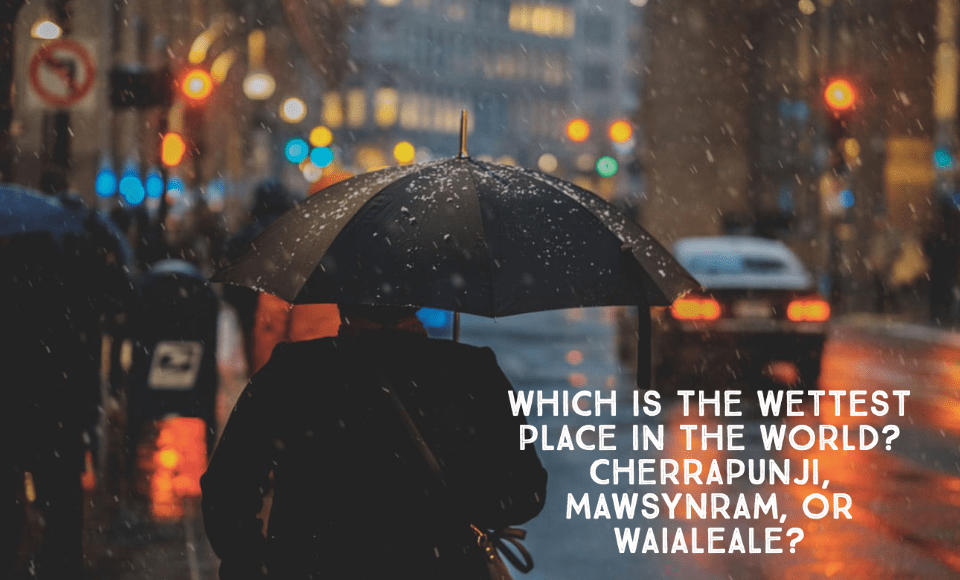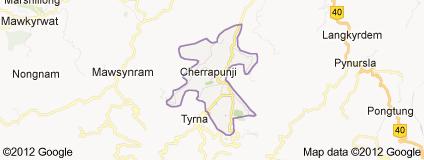
Our world is full of fascinating places. From deserts, where it can get above 131 degrees Fahrenheit during the day and can shift to below freezing point during the nights to areas situated near the polar regions where a single night or day can last up to half a year, each continent is filled with unexplored mysteries. If you ever had an especially rainy day that lasted for hours, then you might want to take a look at those places in the world where it almost never stops raining.
To search for the wettest place in the world, let us clear a few things out. There are a lot of locations in the ocean where it rains continuously; however, since the ocean is itself made of water, we are going to disregard those spots. We are only going to consider those places which are located on land and have the highest average rainfall annually.
For almost one and a half centuries, Cherrapunji (a mountainous town in India) was considered to be the city that received the highest rainfall in the world. But later on, when the officials of the meteorological department of India arranged a rain-gauge at the place called Mawsynram, which is just 9 kilometers away from Cherrapunji (see map below), it put the record of Cherrapunji at stake. The rain-gauge at Mawsynram measured more rainfall on average. Also, the American tourist department is publicizing a place named Mt. Waialeale on the Hawaii Islands as the world’s wettest place in order to attract tourists.
In recent years, there have been many monsoons when the status of Cherrapunji has been viewed askance. For example, in 2008, Mawsynram received 14 985 millimeters of rainfall. The second highest rainfall was noted in Waialeale at 11 684 millimeters in one year, and the third-highest rainfall occurred in Cherrapunji, which received 11 415 millimeters of rainfall.
Cherrapunji is situated at a crucial location at an altitude of 1 313 meters (4 307 feet) in the Khasi mountain range of the Meghalaya state of India. The south-westerly and north-easterly winds meet here. As a result, Cherrapunji gets the benefit of two rainy seasons. This is known as ‘relief precipitation’ in meteorological jargon. This phenomenon is the sole reason for the heavy rainfall which Cherrapunji receives. The humid air travels through the jungles on the Khasi hills, clashes against the mountain range, and moves in an upward direction. When this moisture encounters the cold air at that height, it condenses to form raindrops, and the clouds, full of water, rain down on Cherrapaunji.
The devaluation of Cherrapunji as the world’s wettest place is not quite correct. The amount of rainfall depends on where the rain-gauge has been placed. Just as the meteorological department arranged the rain-gauge at Mawsynram, a place only 9 kilometers away from Cherrapunji, they could have placed another gauge at some other site in Cherrapunji itself, and this could have measured rain more than that at Mawsynram.
The case of the mountain known as Mt. Waialeale is not very strong either. There is no specific monsoon there. There is a continuous rainfall for about 335 to 350 days in a year — and that too in the limited area of about 5 square kilometers. (Mt. Waialeale is on Kauai Island in the sea, and there is no human habitation there.) The rainfall of Cherrapunji covers an area of about 100 to 200 square kilometers.
In spite of this, the circumstances are such that Cherrapunji might lose its numero uno status with the passage of time. For the past few years now, the average rainfall received by this place has gone down to some extent because the forests on the Khasi hill slopes have continuously been felled for wood in order to fulfill the needs of fuel and to make space for agriculture. Once the vegetation is destroyed, the crags and soil of the mountains that have been rendered uncovered absorb the moisture present in the air, so they themselves become moist. Consequently, rain clouds do not form. To change this situation, the environment department of Meghalaya state has started planting trees on the slopes of the Khasi hills on a large scale. It remains to be seen if the year and a century-long record of Cherrapunji as the place that receives the highest rainfall remains intact or not.
Additional reading:
Cherrapunji (Wikipedia)
Mount Waialeale (Wikipedia)
Related posts:

